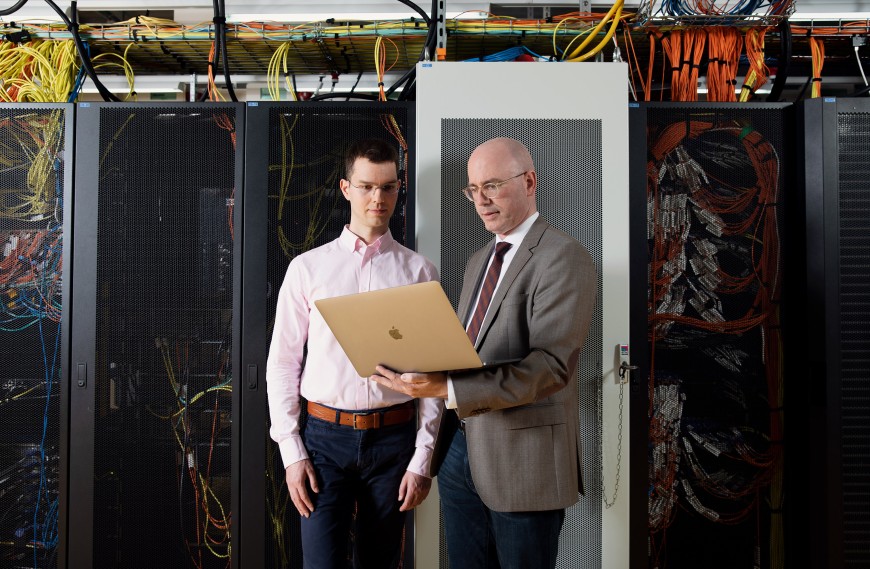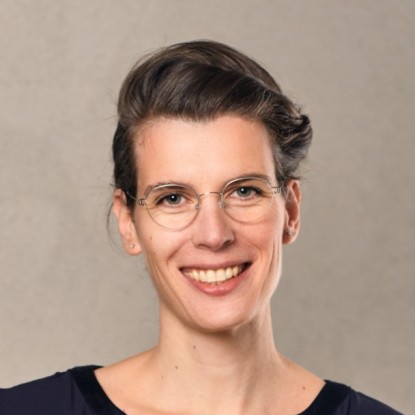Simulated synapses
Research at the Institute of Parallel Programming
24.06.2019
Computer scientists from TU Darmstadt are using a trick from astrophysics to predict the rewiring of nerve cells in the brain. The aim of their model is to support neurosurgeons and advance artificial intelligence.

Gazing into the stars has already helped many people to solve a problem – not just spiritually minded contemporaries but also Professor Felix Wolf and his research associate Sebastian Rinke from the Department of Computer Science at TU Darmstadt. The two researchers aim to calculate the human brain or, to be more precise, the rewiring of its 100 billion nerve cells. No easy task, each nerve cell has a type of cable, called axon, with thousands of terminals. They send out chemical neurotransmitters or emit electric impulses to other neurons, as nerve cells are also termed. For the reception of these signals, each neuron has finely branched antennae that integrate with thousands of terminals from other neurons to form synapses. “Calculating such a network is too much even for a supercomputer”, says Wolf.
Astrophysicists face a similar challenge: our Milky Way has at least 100 billion stars and even more planets. Anyone wanting to calculate the position of a celestial object must account for the gravitational forces exerted by all the others. As this problem cannot be solved by any computer in the world, the astronomers Josh Barnes and Piet Hut developed an approximation method back in the 1980s. It simplifies the calculation by combining the celestial objects to form groups. The interactions are then no longer calculated for pairs, but instead the forces emanating from sufficiently distant objects are grouped. “We were inspired by this idea and have built a bridge to the neurosciences”, says Wolf. Together with Rinke, both still at RWTH Aachen at that time, he started using the Barnes-Hut algorithm to calculate the neural network. According to Wolf, there was a reason why nobody had this idea before: “neuroscientists hardly ever talk to astrophysicists”.
Wolf, however, was not only fascinated by astronomy but also by brain research. During his time at RWTH Aachen, where he was a professor from 2009 to 2015, he met the neuroscientist Markus Butz-Ostendorf. A computer model, to a significant extent co-developed by him, simulated the rewiring of neurons and, in doing so, did not restrict itself – as previous models – to the amplification or weakening of existing synapses, but instead created new links. These constantly form in the adult brain.
The new approach assumes that neurons strive to achieve a certain level of activity: if they receive too little input, they form more synapses. If they are over-stimulated, they reduce their contacts. Experiments carried out on mice confirm the validity of the model. However, it cannot handle more than 100,000 neurons, equivalent to the brain size of a fruit fly, as the size of the task grows quadratically with the number of nerve cells. That means: doubling the number of nerve cells increases the calculation time by a factor of four. For the almost 100 billion neurons of the human brain, the size of the task becomes overwhelming.
Modified model
This is where the Barnes-Hut algorithm comes into play, however, in a modified form, as Rinke explains: “Unlike astrophysicists, we do not calculate any forces but instead connection probabilities”. The original brain model calculated the probability of synapse formation for all pairs of neurons. The modified model, however, places the nerve cells into groups and calculates the probability of a neuron to connect to such a group. The group is then unfolded, subdivided further and the procedure is repeated. “I perform this until I finally encounter individual neurons again”, explains Rinke. Using this method, he simulated a network of one billion nerve cells – more than in a rat’s brain – as part of his dissertation.
“With extrapolations we were able to show that a sufficiently large computer, based on current technology, can even calculate a network comprising 100 billion nerve cells”, adds Wolf. The simulation of neural networks is of medical interest as our brain is not at all hardwired: After a stroke, after the amputation of limbs, but also when learning, remembering and for many other processes, new synapses form while defunct ones disappear. If reorganisation could be predicted, doctors could optimize brain surgery and the treatment of neurological disorders. The timing and scope of the treatment of stroke patients, for example, could be planned better if one knew more precisely how and at which speed the brain recovers. Neurosurgeons, in turn, could in particular protect those areas of the brain during surgery that regenerate less well. The clinical application of the model is still a vision, stresses Wolf: “We must first evaluate how our simulations relate to patient data”. The computer scientists from Darmstadt are already planning to cooperate with clinical partners to compare their calculations with brain scans of patients before and after surgery.
In the future, the model could also boost the further development of artificial intelligence. “The network in our brain is key to our learning ability”, says Wolf, “and if the rewiring is understood better, biologically inspired learning processes and artificial neural networks could be optimised“. Likewise, this is only a rough concept. Anyway, apart from the potential applications, this research is primarily about one thing: a deeper understanding of the processes in our most important organ.
Uta Neubauer

